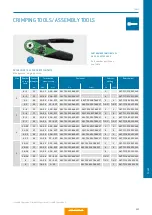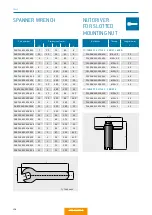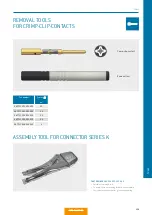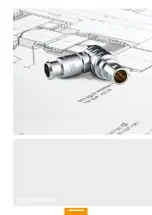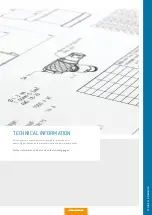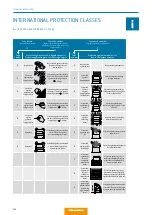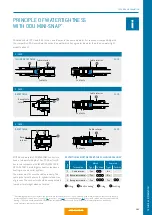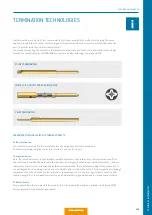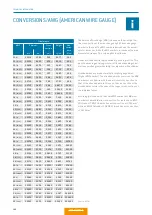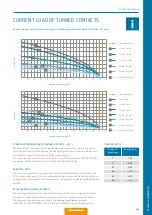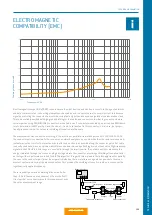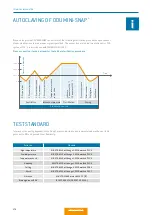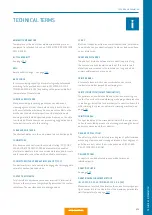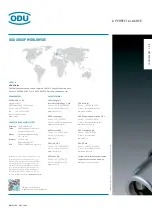
171
TECHNICAL INFORMATION
TE
CHN
IC
AL I
NF
ORMA
TI
ON
TECHNICAL TERMS
AMBIENT TEMPERATURE
Temperature of the air or other medium in which a piece of
equipment is intended to be used. (IEC 44/709/CDV:2014 (VDE
0113-1:2014).
AUTOCLAVABILITY
See page 170.
AWG
American Wire Gauge – see page 166.
BASE CURVE
A current-carrying capacity curve metrologically determined
according to the method described in IEC 60512-5-2:2002
(DIN EN 60512-5-2:2003) depending on the permissible limit
temperature of the materials.
CHEMICAL RESISTANCE
Many secondary processing procedures use adhesives,
cleaning agents or other chemicals on our products. Contact
with unsuitable chemicals may have an adverse e
ff
ect on the
mechanical and electrical properties of the insulation and
housing materials which spec
ifi
ed properties may not be able
to withstand. Please observe our processing suggestions and
technical instructions in this catalog.
CLEARANCE DISTANCE
The shortest distance in the air between two conductive parts.
CONNECTORS
Also known as connectors without contact rating (COC): (IEC
61984:2008 (VDE 0627:2009). An element which enables
electrical conductors to be connected and is intended to create
and/or separate connections with a suitable counterpart.
CONNECTOR WITHOUT BREAKTING CAPACITY (COC)
Connector which is not deemed to be engaged or disengaged in
normal use when live under load.
CONTACT RESISTANCE
Total resistance value measured from terminal to terminal. In
this case, the resistance is si
gnifi
cantly lower than the contact
resistance. The spec
ifi
cations are average values.
CORES
Electrical conductor, solid wire or multi-wire strand, with insula-
tion as well as any conductive layers. Cables or leads may have
one or more cores.
CREEPAGE DISTANCES
The shortest distance between two conductive parts along
the surface of a solid insulation material. This factors in all
elevations and recesses in the insulator, as long as defi ed
minimum dimensions are on hand.
CRIMP BARREL
A terminal sleeve which can accommodate one or more
conductors and be crimped by a crimping tool.
CRIMP CONNECTION (CRIMP TERMINATION)
The permanent, non-detachable and solder-free mounting of a
contact to a conductor via deforming or shaping under pressure
to make a good electrical and mechanical connection. Executed
with crimping tool, press or automatic crimping machine (see
page 156).
CRIMPING AREA
The spec
ifi
ed area of the crimp barrel in which the crimp termi-
nation is executed by means of deforming or shaping the barrel
under pressure around the conductor.
DEGREE OF POLLUTION
The e
ff
ect of pollution is factored in as degree of pollution when
measuring clearance and creepage distances. Four degrees of
pollution are defi ed for the micro-environment: IEC 60664-
1:2007 (VDE 0110-1:2008).
DELIVERY FORM
Connectors can be delivered in assembled form or as
individual parts.
DERATING CURVE
See page 167.
DERATING MEASUREMENT METHOD
IEC 60512-5-2:2002 (DIN EN 60512-5-2:2003)
Measurement method to determine the current-carrying capac-
ity of connectors in consideration of the maximum permissible
limit temperature (see page 167).
Summary of Contents for MINI-SNAP K Series
Page 10: ...ODU MINI SNAP Table of Contents...
Page 16: ...ODU MINI SNAP Table of Contents...
Page 17: ...CONFIGURATION GUIDELINE Correct configuring step by step CONFIGURATION Table of Contents...
Page 22: ...ODU MINI SNAP Table of Contents...
Page 37: ...89 SERIES K SERIES K FOR YOUR NOTES Table of Contents...
Page 55: ...107 SERIES K SERIES K FOR YOUR NOTES Table of Contents...
Page 61: ...113 SERIES K SERIES K FOR YOUR NOTES Table of Contents...
Page 62: ...ODU MINI SNAP Table of Contents...

